Asynchronous serial port communication, handshake mechanism, data frame, Asynchronous Serial Port Design and Experiment – FII-PRA040 Risc-V FPGA Board Experimental 10
Experiment 10 Asynchronous Serial Port Design and Experiment 10.1 Experiment Objective Because asynchronous serial ports are very common in industrial control, communication, and software debugging, they are also vital in FPGA development. the basic principles of asynchronous serial port communication, handshake mechanism, data frame Master asynchronous sampling techniques Review the frame structure of the data packet Learning FIFO Joint debugging with common debugging software of PC (SSCOM, teraterm, etc.) 10.2 Experiment Implement Design and transmit full-duplex asynchronous communication interface Tx, Rx Baud rate of 11520 bps, 8-bit data, 1 start…
Read More









